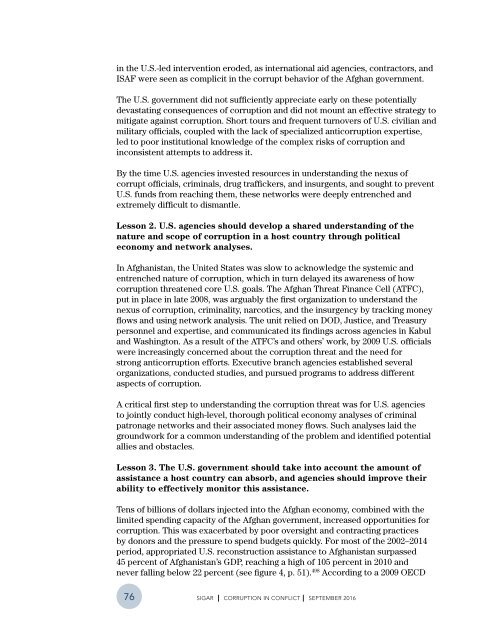CORRUPTION IN CONFLICT
5IlaWjQej
5IlaWjQej
You also want an ePaper? Increase the reach of your titles
YUMPU automatically turns print PDFs into web optimized ePapers that Google loves.
in the U.S.-led intervention eroded, as international aid agencies, contractors, and<br />
ISAF were seen as complicit in the corrupt behavior of the Afghan government.<br />
The U.S. government did not sufficiently appreciate early on these potentially<br />
devastating consequences of corruption and did not mount an effective strategy to<br />
mitigate against corruption. Short tours and frequent turnovers of U.S. civilian and<br />
military officials, coupled with the lack of specialized anticorruption expertise,<br />
led to poor institutional knowledge of the complex risks of corruption and<br />
inconsistent attempts to address it.<br />
By the time U.S. agencies invested resources in understanding the nexus of<br />
corrupt officials, criminals, drug traffickers, and insurgents, and sought to prevent<br />
U.S. funds from reaching them, these networks were deeply entrenched and<br />
extremely difficult to dismantle.<br />
Lesson 2. U.S. agencies should develop a shared understanding of the<br />
nature and scope of corruption in a host country through political<br />
economy and network analyses.<br />
In Afghanistan, the United States was slow to acknowledge the systemic and<br />
entrenched nature of corruption, which in turn delayed its awareness of how<br />
corruption threatened core U.S. goals. The Afghan Threat Finance Cell (ATFC),<br />
put in place in late 2008, was arguably the first organization to understand the<br />
nexus of corruption, criminality, narcotics, and the insurgency by tracking money<br />
flows and using network analysis. The unit relied on DOD, Justice, and Treasury<br />
personnel and expertise, and communicated its findings across agencies in Kabul<br />
and Washington. As a result of the ATFC’s and others’ work, by 2009 U.S. officials<br />
were increasingly concerned about the corruption threat and the need for<br />
strong anticorruption efforts. Executive branch agencies established several<br />
organizations, conducted studies, and pursued programs to address different<br />
aspects of corruption.<br />
A critical first step to understanding the corruption threat was for U.S. agencies<br />
to jointly conduct high-level, thorough political economy analyses of criminal<br />
patronage networks and their associated money flows. Such analyses laid the<br />
groundwork for a common understanding of the problem and identified potential<br />
allies and obstacles.<br />
Lesson 3. The U.S. government should take into account the amount of<br />
assistance a host country can absorb, and agencies should improve their<br />
ability to effectively monitor this assistance.<br />
Tens of billions of dollars injected into the Afghan economy, combined with the<br />
limited spending capacity of the Afghan government, increased opportunities for<br />
corruption. This was exacerbated by poor oversight and contracting practices<br />
by donors and the pressure to spend budgets quickly. For most of the 2002–2014<br />
period, appropriated U.S. reconstruction assistance to Afghanistan surpassed<br />
45 percent of Afghanistan’s GDP, reaching a high of 105 percent in 2010 and<br />
never falling below 22 percent (see figure 4, p. 51). 498 According to a 2009 OECD<br />
76<br />
SIGAR I <strong>CORRUPTION</strong> <strong>IN</strong> <strong>CONFLICT</strong> I SEPTEMBER 2016


